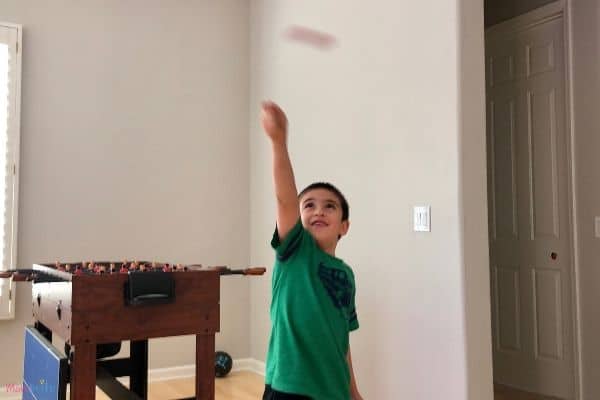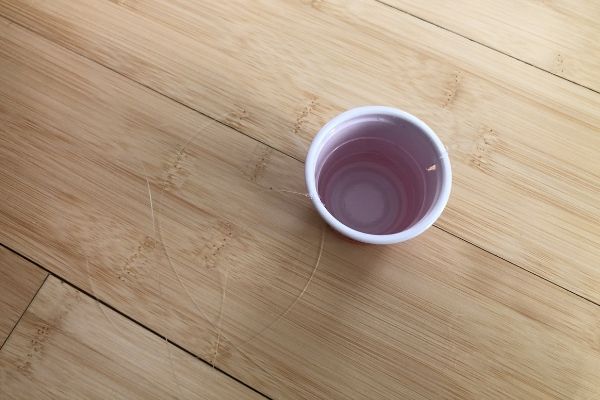Can you flip a cup of water upside-down over your head without getting soaked? Seems impossible, right? That’s what my kids thought at first, and imagine their faces when they were proven wrong!
In this gravity-defying experiment, you can perform the impossible with a simple physics trick. We will explore the concept of centripetal force and how it manages to keep you dry.

Gravity-Defying Water Activity
Materials:
- Plastic cup
- Water
- Optional: Coin
- String
- Scissors
Directions:
** Before I have my kids do the upside-down water in the cup trick, I have them practice with a coin first. It’s an optional step, but I really recommend it so you don’t get water all over the house. If you do use a coin, I suggest you do it away from any mirrors or windows just in case!
- Carefully poke a hole near the top of the rim of the plastic cup.
- Make another hole on the other side of the cup directly opposite the hole you made in step #1.
- Cut a piece of string about 4-5 feet long.
- Tightly tie one end of the string to each hole in the cup.
- Fill the cup about halfway full of water.
- Find an area in the house where you can twirl the cup without hitting anyone or anything. Better yet, go outside so you don’t need to worry about spilling a little water.
- Begin by slowly swinging the cup and when you are ready, swing it in a complete circle.
- When you want to stop, make sure you do not stop abruptly. Swing the cup a few times and slowly bring the cup to a stop.
Did you manage to get the cup with water to go in a full circle without getting wet? If water did spill out, you may not be swinging hard enough. You need to generate enough acceleration to combat gravity.

I had my kids practice with a coin in the cup instead of starting them out right away with water. Since the coin is heavier, it’s easier to generate enough force to keep the coin in the cup instead of falling out on the floor. I will explain more in a bit.
My kids initially had trouble understanding that they need to swing the cup in a full circle. Curiosity would get the best of them and they would look up when the cup is over their heads and forget to keep twirling. Good thing we used a small plastic cup so only a few tablespoons of water ended up on their heads and the floor!
Science Behind the Gravity-Defying Water
According to Newton’s Law of Motion, “a body at rest will remain at rest, and a body will remain in motion unless it is acted upon by an external force.” The external force here is the centripetal force.
In order for an object to move in a circular path, a continuous centripetal forced must be applied at a right angle (tangential) to its path. In this case, the tension force in the string is the centripetal force that is always directed towards the center of the circular path.
To make kids understand centripetal force better, you can bring it up next time you are driving in the car. When a car turns a corner, you feel like you are being pushed by an invisible force against the car door, toward the outside of the curve. You are not actually being pushed. Your body wants to continue moving in a straight line (inertia).
Thankfully, due to Newton’s Third Law (“for every action, there is an equal and opposite reaction.”), you do not go flying out of the car. Just as you exert a force on your seat when you sit on it, the friction of the seat exerts an equal and opposite force on your body and pulls you along the curve with the car. Sometimes the force is not enough so you might fall over – that’s why it’s a good idea to wear a seatbelt! The force that makes your body turn is the centripetal force.
So in the case of the cup with water, the same concept applies. The water is your body and the cup is the car. You can also think of what happens when you go through a vertical cursive on a roller coaster. Without centripetal force, the rollercoaster would fall down when it reaches the top of the curve. Nobody wants that!
Science Extensions
- Make your string longer or shorter. Does the length of the string make it easier or harder to keep the water in the cup?
- Instead of making a vertical circle, try and spin the cup in a horizontal circle over your head. Do you need to spin it faster to keep the water in the cup?
- Try it with different objects in the cup. How does the weight of the objects affect how fast you need to spin the cup?
- Add more water to the cup. Do you need to spin the cup faster for the water to stay in?
Final Thoughts on the Spinning Cup Science Experiment
Even though this is a simple science experiment, it demonstrates the centripetal force in a way that your children can understand. Plus, the idea of potentially dumping water on their heads makes this experiment a super exciting one!
For more water experiments, check out:

